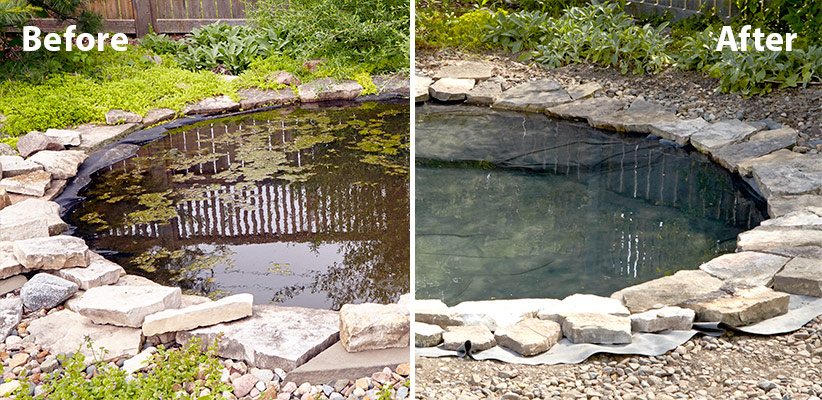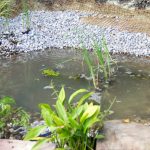Algae in a pond can be a nuisance, turning the water green and depleting oxygen levels. However, there are several effective methods to control and eliminate algae growth in your pond. In this article, we will explore these methods and provide valuable insights on how to maintain a healthy and clear pond environment.

Credit: www.gardengatemagazine.com
1. Manual Removal
One of the simplest ways to control algae in a pond is through manual removal. This involves physically removing the algae from the water using a rake or net. By regularly skimming the surface and removing excess algae, you can prevent its rapid growth and keep the pond water clear. Manual removal is one of the most effective processes in how you can get rid of pond algae without killing fish.
2. Use of Barley Straw
Barley straw is a natural and effective method for controlling algae in ponds. When barley straw decomposes in the water, it releases compounds that inhibit the growth of algae. Simply place a small bale of barley straw in your pond to help prevent algae from taking over.
3. Beneficial Bacteria
Introducing beneficial bacteria into the pond can help to maintain a healthy balance and reduce algae growth. These bacteria work by consuming excess nutrients in the water, which are the primary food source for algae. Consider using specialized bacterial products designed for pond maintenance.
4. Aeration
A well-aerated pond can discourage the growth of algae. By installing a fountain or aerator, you can increase oxygen levels in the water, which can help to limit algae proliferation. Adequate aeration also promotes the growth of beneficial bacteria that compete with algae for nutrients.
5. Chemical Treatments
When manual and natural methods are insufficient, chemical treatments can be used to control algae. Algaecides are designed to target and eliminate algae, restoring clarity to the pond water. However, it is important to use these products cautiously and in accordance with the manufacturer’s instructions to avoid harming other aquatic life.
6. Shading the Pond
Limiting the amount of sunlight that reaches the pond can help to prevent excessive algae growth. You can achieve this by adding floating plants, such as water lilies, or installing shade structures around the pond. Reduced sunlight can inhibit the photosynthesis process that fuels algae growth.

Credit: www.youtube.com
7. Regular Maintenance
Consistent maintenance practices are essential for keeping algae at bay. This includes removing debris, such as fallen leaves and twigs, that can contribute to nutrient buildup in the water. Regular water testing and monitoring can also help in identifying and addressing potential algae issues early on. Not just for ponds, if you have a pool in the backyard and there is also algae and you want to know how you can remove your pool algae then do regular maintenance.
Frequently Asked Questions
Q: What causes algae to grow in a pond?
A: Algae thrive in ponds with excess nutrients (like nitrogen and phosphorus), warm temperatures, and plenty of sunlight.
Q: How can I prevent algae from growing in my pond?
A: Reduce nutrient levels by avoiding overfeeding fish, regularly removing debris, and limiting the use of fertilizers near the pond. Adding plenty of aquatic plants can also help compete with algae for nutrients.
Q: What are the different types of algae commonly found in ponds?
A: Common types include green water algae (single-celled, free-floating), string algae (filamentous), and blue-green algae (cyanobacteria).
Q: Can I use chemicals to kill algae in my pond?
A: Algaecides can be effective but should be used sparingly and as a last resort, as they can harm fish and plants if not used correctly. Always follow the instructions and consider natural alternatives first.
Q: What are some natural methods to control algae in my pond?
A: Natural methods include adding beneficial bacteria, installing a UV clarifier, increasing aeration, and adding more aquatic plants to compete with algae for nutrients.
Q: How do UV clarifiers help control algae?
A: UV clarifiers kill algae by exposing them to ultraviolet light as the water passes through the device, which helps clear green water algae without chemicals.
Q: Can barley straw help reduce algae?
A: Yes, barley straw releases compounds that inhibit algae growth as it decomposes. Place barley straw bales or extract in the pond for a natural algae control method.
Q: How does aeration help reduce algae?
A: Aeration improves water circulation and oxygen levels, which can prevent stagnant areas where algae thrive and support beneficial bacteria that compete with algae for nutrients.
Final Words
Algae control in a pond requires a multi-faceted approach, combining manual, natural, and, if necessary, chemical methods. By implementing these strategies and maintaining a balanced ecosystem, you can effectively manage and eliminate algae, ensuring a clear and healthy pond environment for aquatic life.





